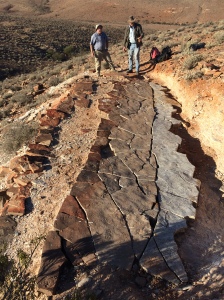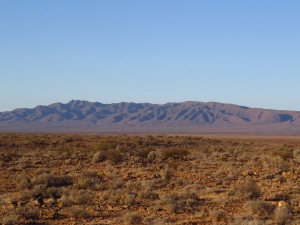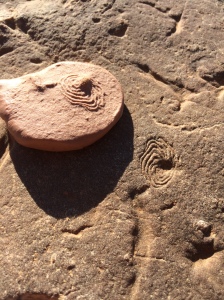I’ve had one of the most mind-blowing weeks of scientific discovery in my career, and it’s not even about a subject from within my field.
As some of you might know, I’ve been getting more and more interested in palaeo-ecology over the past few years. I’m fascinated by the challenge of reconstructing past communities and understanding how and why they changed. It’s a natural progression for someone interested in modern extinction dynamics.
Most of my recent interests have focussed on palaeo-communities of the Late Quaternary, and mainly in the range of 100 thousand years ago to the present. We’ve started publishing a few things in this area, and I can confirm that they’ll be plenty more to come in the following months and years. Despite plenty more to do in the youngest of palaeo-communities, I’ve now been bitten by the deep-time bug.
When I write ‘deep time’, I bloody well mean it: back to 580 million years, to be accurate. This is the time before the great Cambrian explosion of life popularised by the late Stephen Jay Gould in his brilliant book, Wonderful Life1,2. I’m talking about the Ediacaran period from 635-541 million years ago.
I’ve lived in South Australia now for over seven years, but it was only in the last few that I realised the Ediacaran was named after the Ediacara Hills in the northern Flinders Ranges some 650 km north of Adelaide where I live, and it wasn’t until last week that I had the extremely gratifying privilege of visiting the region with some of the world’s top Ediacaran specialists. If you have even the remotest interest in geological time and the origin of life on Earth, you should make a pilgrimage to the Flinders Ranges at some point before you die.

Guy Narbonne & Jim Gehling looking over a jigsaw puzzle of sandstone containing hundreds of fossils. © CJA Bradshaw
A few months ago a good mate of mine at the University of Adelaide, Diego García-Bellido, invited me to a meeting with him, one of his students (Felicity Coutts) and world Ediacaran authority, Jim Gehling of the South Australian museum. They wanted to see if I was interested in collaborating on describing the palaeo-communities they had unearthed from the Flinders Ranges. What do I know about that sort of thing? Nothing. Turns out though, I was hooked almost from the moment I walked into the room.
What they showed me was a giant cast of a slab of inter-connected sandstones dating back to 550 million years ago. The slab of pre-Cambrian sandstone showed the ripples as they had formed on a shallow seabed, and had hundreds of tiny fossilised animal casts embedded in it. Issues of pixelation (grain size) and deformation (animals squished by a heavy layer of sand) aside, I was essentially looking at a photo of a benthic animal community from before the Cambrian explosion. Excuse my French, but ‘fuck me’ was all I could think.

My right foot in the Ediacaran; my left in the Cambrian; 10 million years between my legs. © CJA Bradshaw
Not before, and certainly not since until humans started taking notes on community composition, had there ever been such a dataset. The problem is that after the Ediacaran, animals burrowing into sediments disturbed the spatial relationships between individuals in preserved communities, such that anything approaching community ecology was largely impossible (apart from a description of what was there or not in time). Not so for these pre-ancient benthic communities of some of the first forms of multicellular life.
So, with my ecologist hat on, I agreed to co-supervise Felicity with Jim and Diego, and I’ve started playing with their data. It’s early days yet, and I won’t give too much away here, but the preliminary results are getting me very excited.
I was also invited to join a field expedition to most of the sites, which is what I’ve been doing for the past week. I even took the opportunity to whisk my 7 year-old daughter out of school, because she would be getting a far better education by accompanying me and my colleagues than sitting behind a desk at school.
We were also extremely fortunate to have a few other great Ediacaran specialists along for the trip. Guy Narbonne of Queen’s University in Canada was there, as well as his post-doc, Alex Dececchi. We also had Charnia specialist, Alex Liu of University of Bristol, and two other students of Jim & Diego. As you’ve no doubt guessed, there are a few other really cool Ediacaran sites around the world (Avalon Peninsula in southern Newfoundland, Charnwood Forest in the UK, Nama Assemblage in Namibia, to name some of the more well-known). In other words, our trip was stacked with some of the coolest Ediacaran kids on the block.
Wow. What a week! Even this absolute palaeontology neophyte managed to find fossils that no one had ever seen or identified before. Even my daughter found novel fossils. Dragged from site to site by the incredible stamina of Jim Gehling (a sedimentary geologist with over 40 years experience in the area), we saw amazing fossil site after amazing fossil site, not to mention a wonderful stack of arid-country wildlife, including wedge-tailed eagles, stripe-faced dunnarts, red and grey kangaroos, yellow-footed rock wallabies, zebra finches, echidnas, emus and a variety of small lizards. The scenery was stunning, the history was fascinating, and the fossils were mind-boggling.
What blows my mind almost as much is why this region isn’t a World Heritage Area. The fossil record is second-to-none in terms of evolutionary importance, yet it only has modest protection. The science left to do there is also substantial, and there are too few interested to carry on the long traditions of amazing work done by the likes of Jim and Guy. It’s great that Cambrian specialist, Diego García-Bellido is dipping his toes into these more ancient assemblages, but I still know they are too few for what’s really needed. Scientists the world over should be highlighting this amazing region, and every South Australian in particular should know at least a few Ediacaran species by heart. We should be singing this area’s praises at the top of our voices form the highest peaks in the Flinders. I will do my part to make sure more people know about this unique and precious area.
Thanks to my new friends and colleagues for inviting me along. I enjoyed it beyond what mere words can describe.
1My wife owns an autographed copy
2In a momentous forehead-slapping moment, when I read the book I realised I grew up within spitting distance of the Burgess Shale, but never visited it or even knew about it in my ignorant youth







[…] and start fossicking. I’ve done this now with very experienced sedimentary geologists in the Flinders Rangers looking for 550 million year-0ld Ediacaran fossils, and most recently searching for Jurassic fossils (mainly ammonites) on the southern coast of […]
LikeLike
[…] addition to the surpassing coolness of reconstructing long-gone ecosystems, my new-found enthusiasm for palaeo-ecology has another advantage — most of the species under […]
LikeLike
[…] I don’t care if you are working on Ediacaran assemblages, examining the Cretaceous-Palaeocene mass extinction event, or trying to establish the […]
LikeLike
Attenborough’s First Life is a good introduction for lay people (like me), chapter six, in particular, deals with the Ediacaran fossils. What is the risk of fossil hunters stealing and trashing these treasures?
LikeLike
Jim & Guy are actually in that film
LikeLike
Haven’t seen the film but yes they are in the book.
LikeLike
Brachina, Wilpena etc. I get your excitement.
Delighted that the ecology is being investigated. Will tell us a lot.
Go well.
LikeLike